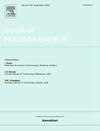紧晶格束内两相流界面面积输运的建模与预测
IF 2.3
3区 工程技术
Q1 NUCLEAR SCIENCE & TECHNOLOGY
引用次数: 0
摘要
界面面积浓度(IAC)是双流体模型的关键参数,决定了界面传递项的本构关系。为了动态预测IAC的发展,提出了界面面积输运方程(IATE)。带P/D <的紧密点阵燃料组件;1.1被广泛应用于小型模块化反应堆的概念设计中。为了研究致密点阵燃料组件的界面输运特性,建立了P/D = 1.06的致密点阵棒束两相流参数数据库,包括空隙率、气泡速度、气泡尺寸分布(BSD)和IAC。BSD和IAC数据是使用内部开发的金属丝网传感器(WMS)结合一种新的后处理方法,即欧拉后处理方法获得的。本文利用紧晶格束通道中的IAC数据对经典IATE模型(包括Fu、Sun和Yang模型)进行了基准测试。结果表明,Fu模型最准确地预测了当前通道中IAC的发展。对于一组(G1)流,Fu模型的平均和最大相对偏差分别为5.1%和14.3%。同时,对于两组(G2)流,Fu模型的平均和最大相对偏差分别为12.1%和25.6%。在Fu模型的基础上,结合紧晶格束中G2气泡的特性,通过修正G2气泡基底剪切周长和形状因子,提出了优化的IATE模型。优化后的模型抑制了剪切项的贡献,大大提高了电流束通道内两群IAC演化的预测精度。对于两组流,新模型的IAC平均相对偏差为6.56%,最大相对偏差为14.9%。然而,计算结果也表明,在某些情况下,由于假设气泡数密度分布平坦,IATE可能无法同步预测IAC和空隙率输运。因此,在未来的研究中,建议开发考虑BSD演化信息的IATE,以进一步提高模型的精度。本文章由计算机程序翻译,如有差异,请以英文原文为准。
Modeling and prediction of interfacial area transport in two-phase flow within a tight lattice bundle
The interfacial area concentration (IAC) is the two-fluid model’s key parameter, determining the interfacial transfer terms’ constitutive relations. To dynamically forecast IAC developments, the interfacial area transport equation (IATE) has been proposed. Tight lattice fuel assemblies with P/D < 1.1 are extensively utilized in the conceptual designs of small modular reactors. To investigate the interface transport characteristics and develop the IATE for the tight lattice fuel assembly, we established a two-phase flow parameter database for a tight lattice rod bundle with P/D = 1.06, covering void fraction, bubble velocity, bubble size distribution (BSD), and IAC. The BSD and IAC data were obtained using an in-house developed wire-mesh sensor (WMS) combined with a new post-processing method, known as the Eulerian post-processing method. This paper utilized the IAC data in the tight lattice bundle channel to benchmark the classical IATE models, including the Fu, Sun, and Yang models. Results indicate the Fu model most accurately predictes the development of IAC in the current channel. For the one-group (G1) flow, the Fu model’s average and maximum relative deviations are 5.1 % and 14.3 %, respectively. Meanwhile, for the two-group (G2) flow, the Fu model’s average and maximum relative deviations are 12.1 % and 25.6 %, respectively. Based on the Fu model, combined with the G2 bubbles’ characteristics in the tight lattice bundle, this paper proposes an optimized IATE model by correcting the G2 bubble base shearing-off perimeter and shape factor. The optimized model suppresses the contribution of the shearing-off term and greatly improves the prediction accuracy of the two-group IAC evolution inside the current bundle channel. For the two-group flow, the new model’s average and maximum relative deviations of IAC are 6.56 % and 14.9 %, respectively. However, calculation results also show that the IATE may not predict the IAC and void fraction transport synchronously in some cases, due to the assumption of a flat bubble number density distribution. Hence, in future studies, the IATE considering BSD evolution information is recommended to be developed to further enhance the model accuracy.
求助全文
通过发布文献求助,成功后即可免费获取论文全文。
去求助
来源期刊

Annals of Nuclear Energy
工程技术-核科学技术
CiteScore
4.30
自引率
21.10%
发文量
632
审稿时长
7.3 months
期刊介绍:
Annals of Nuclear Energy provides an international medium for the communication of original research, ideas and developments in all areas of the field of nuclear energy science and technology. Its scope embraces nuclear fuel reserves, fuel cycles and cost, materials, processing, system and component technology (fission only), design and optimization, direct conversion of nuclear energy sources, environmental control, reactor physics, heat transfer and fluid dynamics, structural analysis, fuel management, future developments, nuclear fuel and safety, nuclear aerosol, neutron physics, computer technology (both software and hardware), risk assessment, radioactive waste disposal and reactor thermal hydraulics. Papers submitted to Annals need to demonstrate a clear link to nuclear power generation/nuclear engineering. Papers which deal with pure nuclear physics, pure health physics, imaging, or attenuation and shielding properties of concretes and various geological materials are not within the scope of the journal. Also, papers that deal with policy or economics are not within the scope of the journal.
 求助内容:
求助内容: 应助结果提醒方式:
应助结果提醒方式:


